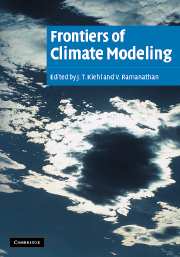Book contents
- Frontmatter
- Contents
- Preface
- List of Contributors
- Acknowledgments
- 1 Overview of climate modeling
- 2 Climate-change modeling: a brief history of the theory and recent twenty-first-century ensemble simulations
- 3 Energy-balance climate models
- 4 Intrinsic climatic variability: an essay on modes and mechanisms of oceanic and atmospheric fluid dynamics
- 5 The radiative forcing due to clouds and water vapor
- 6 A model study of the effect of Pinatubo volcanic aerosols on stratospheric temperatures
- 7 Unresolved issues in atmospheric solar absorption
- 8 Cloud feedbacks
- 9 Water-vapor feedback
- 10 Water-vapor observations
- 11 New frontiers in remote sensing of aerosols and their radiative forcing of climate
- 12 Cloud–climate feedback: lessons learned from two El Niño events
- 13 Runaway greenhouses and runaway glaciations: how stable is Earth's climate?
- Glossary
- Plate section
13 - Runaway greenhouses and runaway glaciations: how stable is Earth's climate?
Published online by Cambridge University Press: 12 August 2009
- Frontmatter
- Contents
- Preface
- List of Contributors
- Acknowledgments
- 1 Overview of climate modeling
- 2 Climate-change modeling: a brief history of the theory and recent twenty-first-century ensemble simulations
- 3 Energy-balance climate models
- 4 Intrinsic climatic variability: an essay on modes and mechanisms of oceanic and atmospheric fluid dynamics
- 5 The radiative forcing due to clouds and water vapor
- 6 A model study of the effect of Pinatubo volcanic aerosols on stratospheric temperatures
- 7 Unresolved issues in atmospheric solar absorption
- 8 Cloud feedbacks
- 9 Water-vapor feedback
- 10 Water-vapor observations
- 11 New frontiers in remote sensing of aerosols and their radiative forcing of climate
- 12 Cloud–climate feedback: lessons learned from two El Niño events
- 13 Runaway greenhouses and runaway glaciations: how stable is Earth's climate?
- Glossary
- Plate section
Summary
Introduction
Is Earth's climate stable? At some level the answer is almost certainly “yes.” The evidence for this is two-fold. First, the geologic record indicates that liquid water has been present on Earth's surface more or less continuously since about 4 Ga. (“Ga” stands for “giga-aeon,” which means “billions of years ago.”) We say “more or less” because, as discussed below, there appear to have been brief periods in Earth's history when the planet was almost entirely frozen. And, second, life appears to have been present since at least 3.5 Ga (Schopf, 1993) and perhaps 3.9 Ga, if carbon isotopes are admitted as indirect evidence (Mojzsis et al., 1996). This latter requirement overlaps the first one to some extent because all organisms require liquid water during at least part of their life cycle. It is more stringent, however, in that liquid water can exist right up to the critical point (374 °C, 220 bar for pure water), whereas the upper temperature limit for life is ∼ 113 °C. (A common misconception is that liquid water requires temperatures below 100 °C, but this is only the boiling point at one atmosphere pressure. The ocean contains the equivalent of ∼ 270 bar of water vapor and so, like water in a pressure cooker, it would not boil until the temperature exceeded the critical temperature.)
Another way of evaluating Earth's climate stability is to compare Earth to its neighboring planets, Venus and Mars.
- Type
- Chapter
- Information
- Frontiers of Climate Modeling , pp. 349 - 366Publisher: Cambridge University PressPrint publication year: 2006



